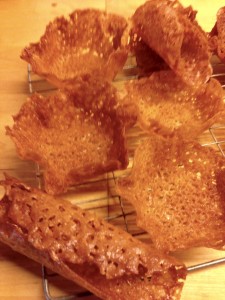
There are numerous variants of the recipe for Brandy Snaps, few make any reference to brandy. A glance down the ingredients might indicate that these are high calorie biscuits and so to be avoided. Certainly they can never be considered ‘healthy’ but each biscuit only requires around a teaspoon or so of the paste so perhaps the final calorie count isn’t quite as bad as some might think. I’m not going to get a calculator out to check.
After searching the internet and various books I decided to use a recipe given by Jane Grigson in her book English Food first published in 1974. This is one of a very few recipes I found that does include brandy in the ingredients.
Curious about the history? Read on.
If you read this blog you will know that we like to know a little of the history of the things we bake. The Oxford Companion to Food by Alan Davidson is always a good starting place. From this source we learn that brandy snaps were around at least as far back as 1898 the ‘lack of discriminative taste peculiar to uneducated palates’ made use of brandy redundant, manufacturing the biscuits without brandy was cheaper and if the target market included those with such ‘uneducated palates’ then they wouldn’t know the difference if the key ingredient was missing!
Wikipedia advises that brandy snaps do not include any brandy in the recipe, rather that they can be served together with whipped cream that incorporates a little brandy. From here we do learn that the biscuits date back a little further than the account provided by Alan Davidson. A publication in 1802, Family Friend or Housekeeper’s Instructor, defined brandy-snaps as a small cake of gingerbread, probably brand-schnap from being burnt, to for the real or supposed presence of brandy.
Mrs Beeton makes no reference to these biscuits despite her Book of Household Management being published in 1861 when brandy snaps must have been well established.
One of the key ingredients of any brandy snap is golden syrup. Jane Grigson writes that this product was not available until the 1880s. Earlier versions of the recipe would have used black treacle instead. Golden syrup is a product developed by the British company Tate and Lyle. Abrams Lyle was a Scottish businessman who had his five sons build a sugar refinery in Greenock in 1881. Mr Lyle knew that the refining of sugar cane produced a treacly syrup that was usually wasted. He began marketing the syrup as ‘Goldie’, at first on a small scale but the product quickly found its market and within weeks the firm was selling more than a tonne a month. The Tate and Lyle website states that the still used green and golden tin has hardly changed since its introduction in 1885. Golden Syrup was awarded a royal warrant in 1911 that it has retained ever since. The firm is named in the Guinness Book of Records as the world’s oldest brand.
Despite the popularity of Golden Syrup in the UK, until recently the product wasn’t easy to find in France. Nevertheless the most recent French series of Bake Off required candidates to produce Les Brandy Snaps for the semi-final to the competition. Mercotte, the Mary Berry of the French Bake Off, published the recipe the candidates were required to use on her website. While Golden Syrup is now relatively easy to find in French supermarkets the recipe imposed on the candidates substituted glucose. Of course the programme was seen by plenty of British viewers and comments left on the web-site go to some lengths to criticise the programme for veering so far from the ‘original’ recipe. Despite that, none of those that took time to express their views publicly to Mercotte advised that older ‘original’ recipes used black treacle.
Reading around the subject, it seems that these biscuits were first popularised as a ‘snack’ food at fairs and fetes. Jane Grigson advises they were sold alongside eel pies and gingerbread. In the 1970s when she wrote English Food, brandy snaps were still sold at Marlborough’s annual fair in large flat rounds. Mrs Grigson thought they made a better alternative than candy floss.
Ingredients (20-30 biscuits)
120g butter
120g Golden Syrup
120g granulated sugar
120g plain flour
10g ground ginger
10g brandy
5g lemon juice
pinch of salt
Prepare baking sheets covered with baking parchment. The biscuits can be cooked in batches making it easier to mould them into rolls or baskets. Any moulding needs to be done quickly after the biscuits come out of the oven, as they cool they become crisp and unworkable.
If you want to make cylinders from your biscuits, the traditional way is to shape them around the handle of a wooden spoon. Lengths of stainless steel pipe are another alternative.
For ‘basket’ shape brandy snaps you can use a ramekin or small bowl as the mould. Silicone ‘cups’ sold for poaching eggs are another alternative, as are the silicone moulds sold to make half spheres of chocolate etc.
Pre-heat oven at 160c
Add butter, syrup and sugar to a heavy based pan, place over a moderate heat and stir until you have a smooth mixture. Make sure the mixture doesn’t become too hot.
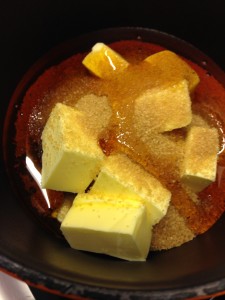
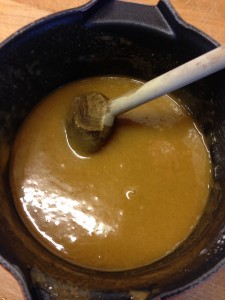
Take the pan off the heat and allow the mixture to cool until it is just tepid.
Still off the heat, stir in flour, ginger, lemon juice, brandy and salt.
Place teaspoons of the mixture onto prepared baking sheets making sure to space them well as they will spread considerably during baking.
Bake at 160c for 8-10 minutes. The time will depend both on your oven and on the amount of mixture you use for each biscuit.
Have any moulding devices to hand immediately the biscuits come out of the oven. You will find that for the first few seconds it is impossible to move the biscuits without damaging them. Quickly though the mixture will begin to cool and you have a small window of time when the biscuits can either be rolled or pressed around whatever moulds you have selected.
These are straight out of the oven:
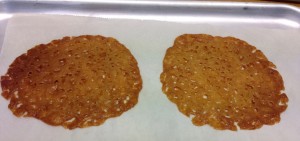
Below are biscuits moulded as baskets and rolls:
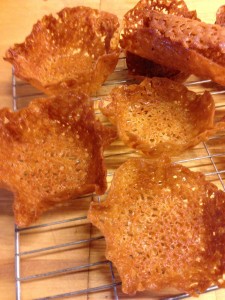
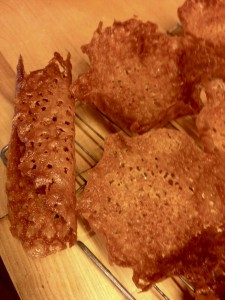
Grigson, Jane (1974) English Food. Penguin books, 1979 edition.
Davidson, Alan (1999) The Oxford Companion to Food, Oxford University Press, 2006 edition.